With a staggering 92 million active buyers, the Etsy Marketplace represents more than just a side hustle opportunity. Instead, it’s a thriving platform that can fuel a sustainable full-time income for your business, whether it’s new or established.
Let’s explore the diverse range of products you can sell on Etsy, gain insights into the community of Etsy sellers, and explore the exciting earning potential that this popular sales channel offers.
How Much Does the Average Etsy Seller Make?
The average earnings of an Etsy seller can vary widely depending on multiple factors including the type of products sold, the seller’s level of experience, marketing efforts, and overall business strategy. Etsy itself does not provide specific data on average earnings for its sellers, but various studies and surveys offer insights into what sellers can expect.
According to a survey conducted by EcommerceBytes in 2020, the majority of Etsy sellers reported earning less than $1000 annually from their Etsy shops. However, this figure does not account for full-time sellers or those who have been able to build successful businesses on the platform.
For more established and successful Etsy sellers, earnings can be significantly higher. Some top-performing sellers, particularly those with unique and in-demand products, can earn six-figure incomes annually. These sellers often invest considerable time and effort into developing their product lines, optimizing their listings, and promoting their shops both within Etsy and through external marketing channels.
To succeed, you must invest effort in conducting thorough market research, optimizing your store and product listings, and actively engaging with your audience. These strategies can be the deciding factor between an average Etsy store and a highly successful one. Success on Etsy demands dedication and strategic planning, but for those willing to put in the work, the platform offers a promising avenue for building a sustainable online business.
Create Your Free Printify Account Today
Is Selling on Etsy Worth It?
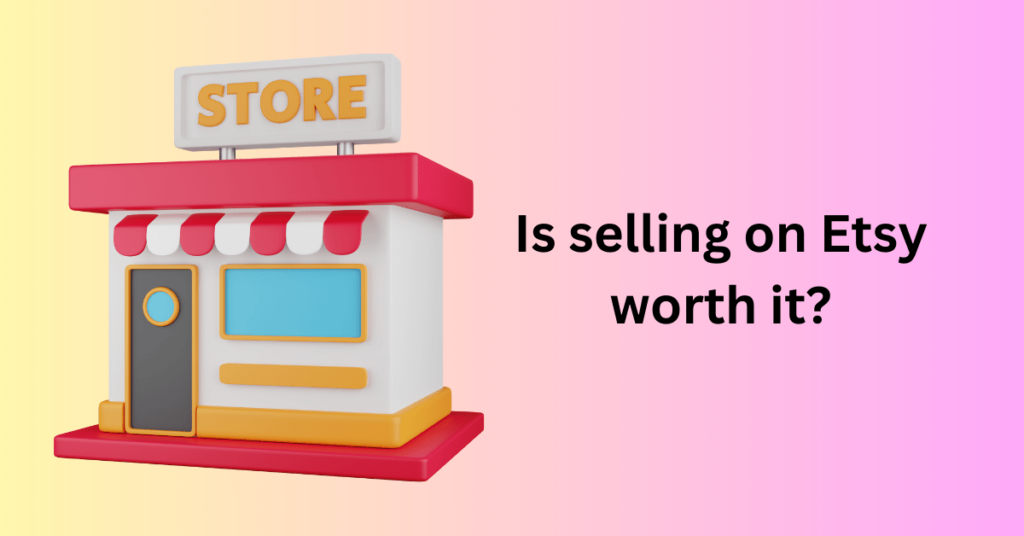
If you’re considering selling your handmade crafts, vintage items, or unique products online, Etsy is likely one of the platforms that has caught your attention. It is a popular marketplace known for its focus on handmade, vintage, and craft supplies. However, whether or not selling on Etsy is worth it depends on various factors. Let’s delve into the pros and cons to help you make an informed decision.
Pros of Selling on Etsy:
1. Large Customer Base: Etsy boasts millions of active buyers globally. This can provide a vast potential customer base for your products. This exposure can lead to increased sales and visibility.
2. Specialized Niche Market: Etsy caters specifically to handmade, vintage, and craft supplies. This makes it an ideal platform if your products fall into these categories. Buyers often come to Etsy seeking unique and personalized items.
3. Easy to Set Up: Creating a shop on Etsy is relatively straightforward and doesn’t require advanced technical skills. You can quickly list your products with photos and descriptions.
4. Community and Support: Etsy has a supportive community of sellers and resources such as forums, blogs, and guides to help you navigate selling successfully on the platform.
5. Low Cost to Start: Compared to setting up a standalone e-commerce website, the costs of starting an Etsy shop are minimal. You pay a small listing fee for each item and a commission when your items sell.
6. Access to Marketing Tools: Etsy offers tools like Promoted Listings and Etsy Ads to help you market your products to a broader audience within the platform.
Cons of Selling on Etsy:
1. High Competition: Due to its popularity, Etsy can be highly competitive. Standing out among millions of listings requires effective marketing and unique products.
2. Fees and Commissions: While the initial costs are low, Etsy charges listing fees, transaction fees, and a percentage of your sales. These fees can add up and impact your profit margins.
3. Limited Branding: Etsy’s platform design doesn’t allow for extensive customization. Your shop may lack a distinctive brand identity compared to having your own website.
4. Policy Changes: Etsy also updates its policies and algorithms periodically, which can affect your shop’s visibility and performance. Adapting to these changes can be challenging.
5. Dependency on Etsy: As a seller on Etsy, you’re subject to their rules and regulations. If it changes its direction or policies significantly, it could impact your business.
6. Customer Communication: Communication with customers is primarily through Etsy’s messaging system, which may not be as flexible or personalized as direct email.
Create Your Free Printify Account Today
Things to Sell on Your Etsy Shop
To thrive on Etsy and attract a wide range of buyers, you can then consider expanding your product offerings with personalized, handmade, digital, and vintage items.
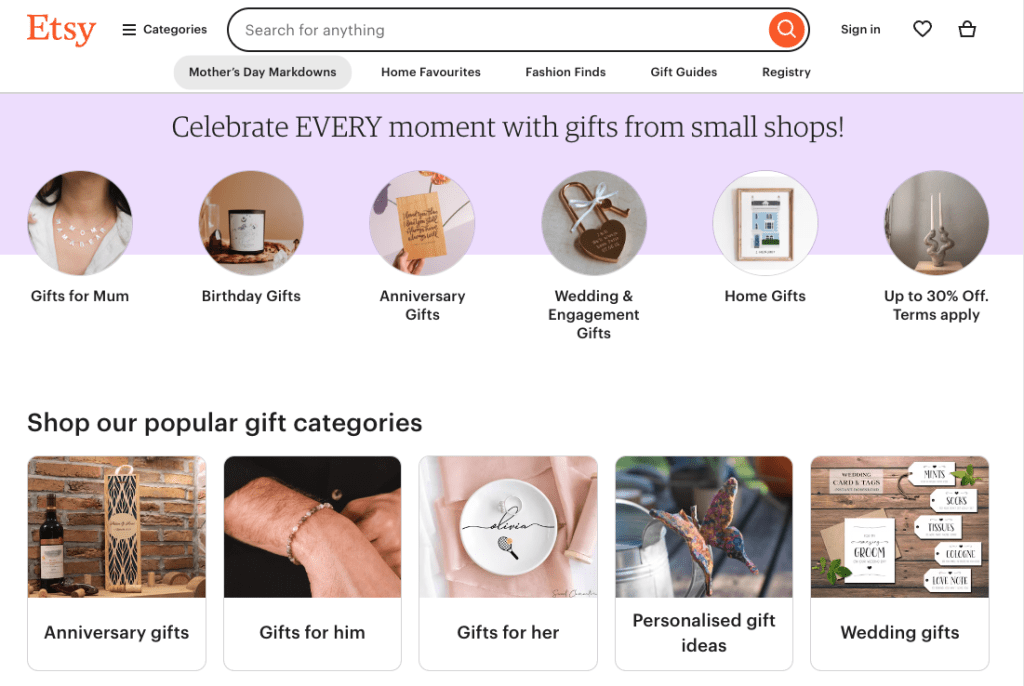
Each category presents unique opportunities to showcase your creativity and cater to diverse customer preferences.
1. Personalized Products
Capture buyers’ attention by offering custom-made goods through Print-on-Demand services like Printify. You can create personalized apparel, accessories, home decor, and party supplies that allow customers to express their unique style.
Besides, you can also enable personalization options on your listings to accommodate specific preferences, enhancing the appeal of your products.
2. Handmade Items
Leverage your crafting skills to sell handmade creations. Whether you specialize in knitting, painting, pottery, or woodworking, Etsy provides an ideal platform to showcase and sell your unique handcrafted goods. So, just stay updated with seasonal trends to ensure your product listings remain relevant and in demand throughout the year.
3. Digital Products
Expand your product offerings by selling digital downloads such as printable art, planners, patterns, and templates. This allows you to reach a broader audience and generate passive income.
You may explore resources like Etsy’s guide on selling digital downloads for inspiration and valuable insights into this growing market segment.
4. Vintage Items
Curate and sell vintage treasures on Etsy, ranging from old electronics and retro clothing to antique furniture. You can share the fascinating history and stories behind each piece to captivate fans of vintage goods worldwide. Stay attentive to market trends and seasonal demand to optimize the visibility and sales of your vintage collection.
It’s important to recognize that success on Etsy requires dedication and perseverance. You need to invest time in conducting market research to understand customer preferences and trends. Besides, you need to optimize your store and product listings by using relevant keywords, compelling descriptions, and high-quality images. Finally, engage with your audience through effective communication and customer service to build lasting relationships and foster loyalty.
Create Your Free Printify Account Today
Tips For Your Etsy Shop Success
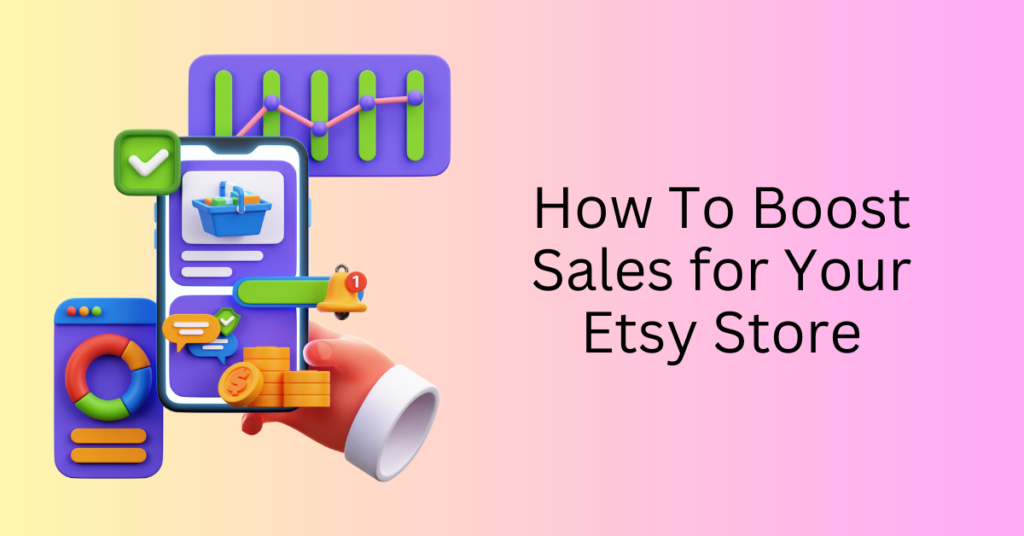
To ensure your Etsy shop stands out and attracts potential buyers, follow these detailed strategies to enhance your product listings, optimize your store profile, and find your niche within the marketplace.
1. Take Exceptional Photos
Invest in good lighting and staging techniques to capture compelling product images. You can consider incorporating lifestyle photos that showcase your products in real-life settings, helping potential buyers visualize their use.
For print-on-demand products, leverage tools like mockup generator to generate high-quality product mockups that highlight your designs effectively.
2. Optimize Your Store and Product Listings
Maximize visibility by using relevant keywords in your titles and descriptions. You can craft detailed product descriptions using bullet points for clarity and readability.
Besides, it is crucial to complete your shop profile by sharing your unique shop owner story and linking to your social media pages. Design an eye-catching shop banner and specify your work hours to enhance professionalism and engagement with potential customers.
3. Find Your Niche
Rather than trying to appeal to a broad audience, focus on identifying and targeting a specific customer niche. Understanding and catering to the needs of a particular demographic increases your chances of attracting genuinely interested buyers, leading to higher sales and improved customer engagement.
4. List a Variety of Products
Enhance your shop’s credibility and appeal by expanding your product range. You can offer a diverse selection of products allows you to cater to a broader audience with varied preferences and needs. This strategy establishes your Etsy store as a reliable source for different types of products, attracting more potential buyers and boosting overall sales.
5. Engage with Your Audience
Regularly engage with your customers by responding promptly to inquiries and feedback. You need to build strong relationships with buyers to encourage repeat business and positive word-of-mouth referrals.
6. Stay Updated with Trends
Monitor market trends and customer preferences within your niche. Incorporate popular themes or seasonal variations into your product offerings to capitalize on current demand and stay relevant to your target audience.
By implementing these strategies, you can optimize your Etsy shop to maximize visibility, attract the right audience, and ultimately drive sales growth. Consistent effort and attention to detail will help you establish a strong presence on Etsy and position your shop for long-term success within the competitive e-commerce landscape.
Mistakes to Avoid With Your Etsy Store
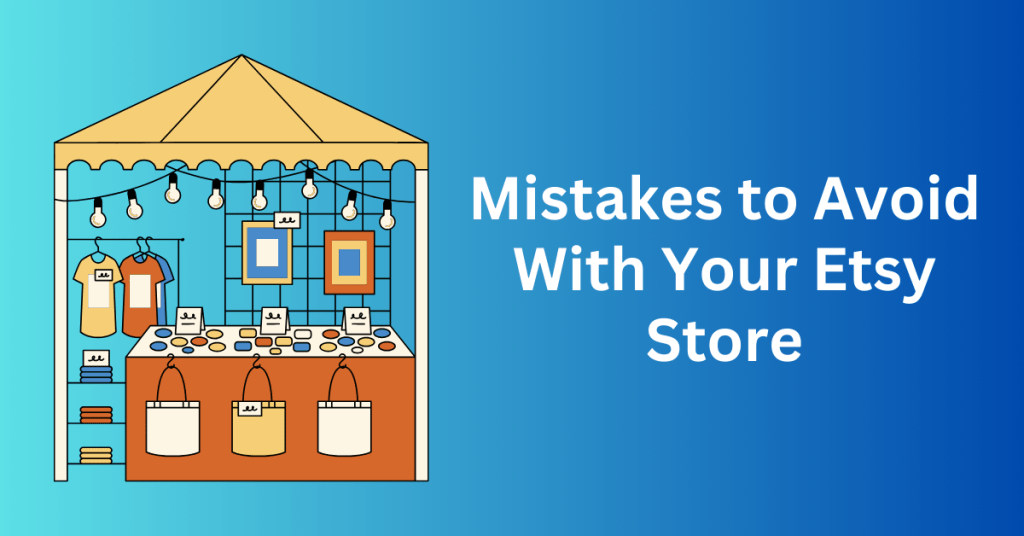
Importance of Research for Etsy Sellers
Many Etsy sellers miss out on valuable resources like the Etsy Seller Handbook, community forums, and tutorials. This can lead to missed opportunities and unnecessary setbacks. It’s essential to familiarize yourself with these resources to gain insights into best practices and strategies for success on the platform before diving into active selling.
Quality Over Quantity in Etsy Listings
Instead of focusing solely on quantity, prioritize quality when creating your product listings. Each listing should accurately represent your products with compelling descriptions and high-quality images. You should aim to have a minimum of ten well-crafted product listings in your shop to attract more customers and increase sales.
Besides, successful sellers on Etsy continuously add new listings. Our experience suggests that adding around ten new listings per week can significantly enhance shop visibility and engagement. Hence, don’t be afraid to experiment with new designs and products to keep your shop fresh and appealing.
Pricing Strategy on Etsy
Pricing your products appropriately is crucial for maximizing your income. Setting prices too low can undervalue your products and diminish your potential earnings. On the other hand, higher prices provide flexibility for offering discounts and promotions, which can attract customers without compromising your profit margins.
Printify recommends setting a profit margin of around 40%. And you can adjust this manually through your Printify Dashboard to align with your business goals and market conditions.
Avoiding Copying Competitors
While it’s important to stay informed about your competitors, directly copying them can hinder your shop’s performance and even lead to legal issues. Instead of mimicking your competitors, use your knowledge to offer unique value through your products and services. Differentiate yourself by focusing on what makes your offerings special and addressing customer needs in innovative ways.
Create Your Free Printify Account Today
Understanding Etsy Fees
Understanding the various fees associated with selling on Etsy is crucial, Although each fee might seem small on its own, they can quickly add up to much larger sums. For instance. Etsy can take an average of 20% to 25% from every sale you make.
Etsy charges several types of fees that sellers should be aware of:
1. Listing Fees
When you create a listing for a product on Etsy, there is a fee per item listed. This fee is currently $0.20 USD per listing, and the listing lasts for four months or until the item is sold.
2. Transaction Fees
Etsy charges a transaction fee on each sale, which consists of a percentage of the total sale price (including the item price and any shipping costs). Etsy takes a 6.5% transaction fee from each sale you make.
3. Payment Processing Fees
When you receive payments from buyers through Etsy’s payment processing system, there are fees associated with processing these payments. This fee varies depending on the country you’re in but typically includes a fixed fee plus a percentage of the transaction amount.
For instance, if you’re based in the US, you can expect a processing fee of 3% plus $0.25 per transaction.
4. Currency Conversion Fees
If you sell in a currency different from your payment account’s currency, Etsy applies currency conversion fees when transferring funds to your bank account.
You need to factor these fees into their pricing strategy to ensure you cover all costs while remaining competitive. Utilizing tools and analytics provided by Etsy can help you to track and manage your expenses effectively.
How to Make Money on Etsy With Print-on-Demand?
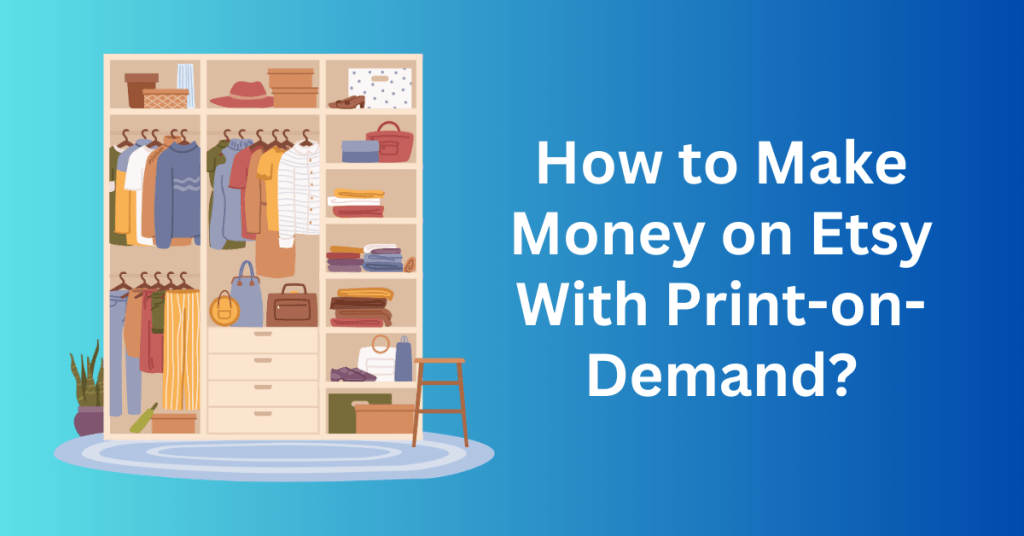
Creating and launching your Etsy shop is an exciting step towards becoming a successful online seller. Follow these detailed instructions to set up your shop and start selling your unique products.
1. Create Your Etsy Shop
Firstly, register for an Etsy account and click on “Get started” to open your shop. The first step is to create a product listing manually, which is necessary to launch your shop.
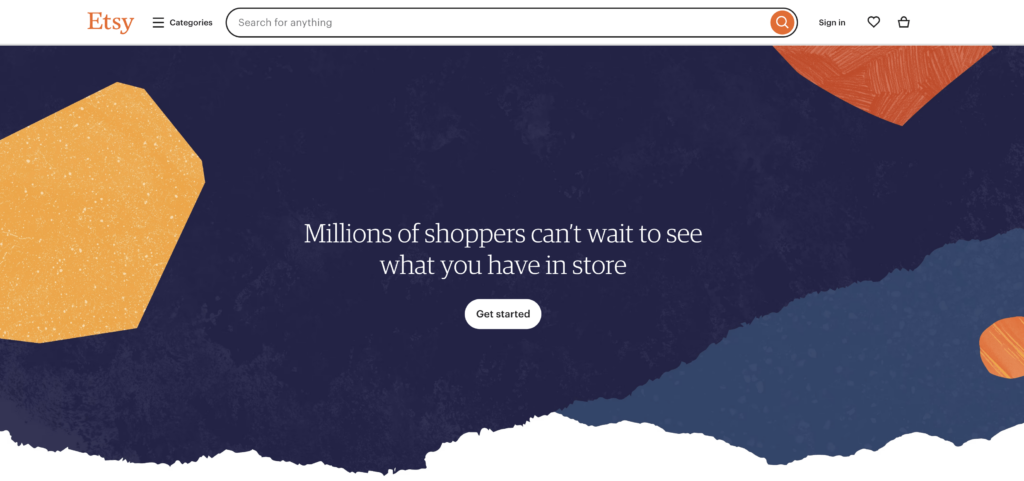
Ensure you also set up your payment and billing information by linking your bank account and providing all required details. Once your shop is live, take the time to personalize it with branding elements that reflect your unique identity and style.
2. Create a Printify Account and Connect to Etsy
Then, sign up for a free account on Printify, a trusted Print-on-Demand partner. You can connect your Printify account to your Etsy store by accessing the Printify Dashboard.
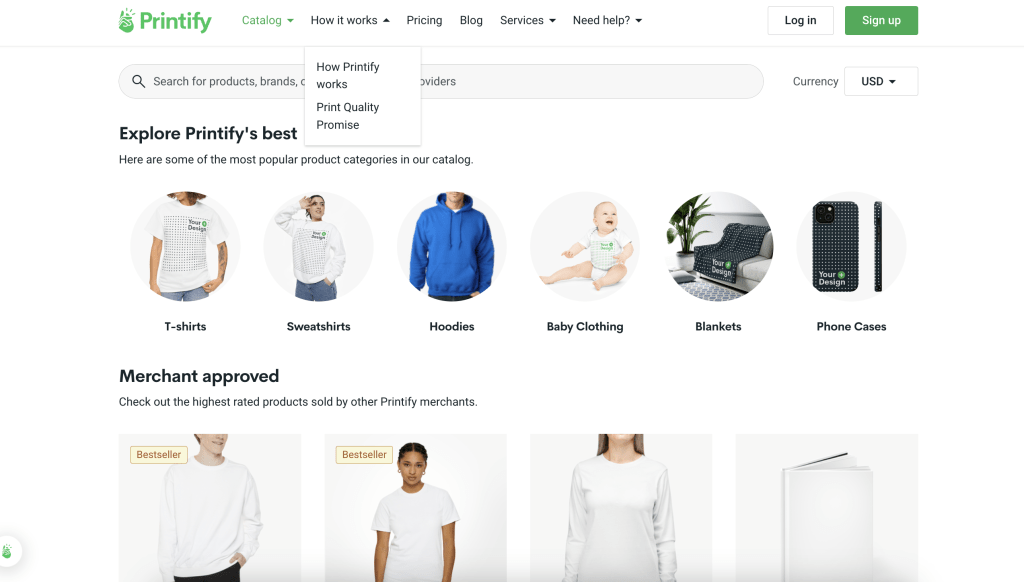
Then, navigate to “Add a new store” and select “Connect to Etsy.” Follow the prompts to link your Printify store to your Etsy Shop Manager. Finally, grant access to the Printify application when prompted.
Create Your Free Printify Account Today
3. Design and Publish Custom Products
You can explore Printify’s extensive Product Catalog, offering over 900 customizable items. Then, select products that align with your brand and create unique designs to personalize them.
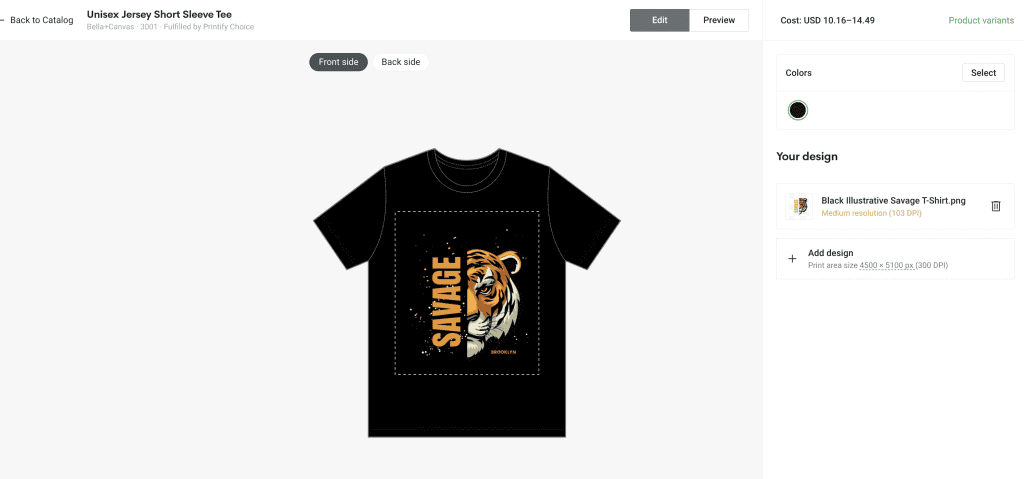
Once your designs are ready, publish them on your Etsy store with just a few clicks. These products will sync as draft listings on your Shop Manager, awaiting your approval for publishing.
4. Optimize and Market Your Listings
In addition, you need to enhance the visibility of your Etsy listings by optimizing them for search engines. You can also use relevant keywords in your titles and descriptions, and upload high-quality images that showcase your products attractively.
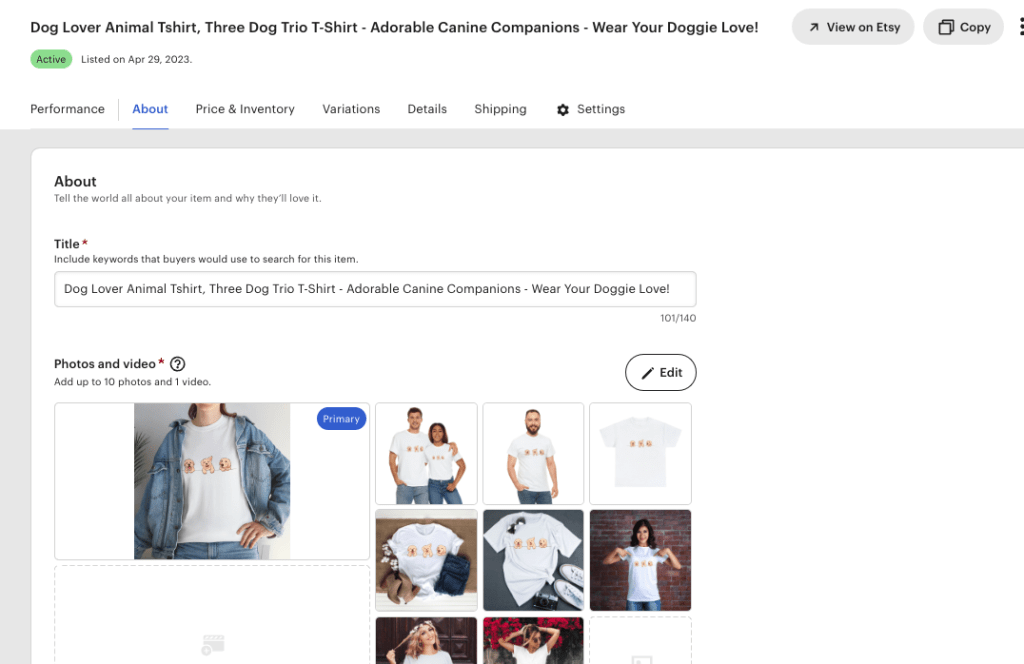
Besides, consider promoting your listings through Etsy Ads and sharing them across your website and social media platforms to reach a broader audience. For additional tips on optimizing your store, explore resources like the Etsy SEO blog provided by Printify.
5. Start Selling Online and Making Money
With Printify handling the fulfilment and shipping of your orders, you can focus on selling and growing your business on Etsy. Having a reliable Print-on-Demand partner streamlines the process. It allows you to concentrate on generating sales and expanding your product offerings.
As your shop gains traction, capitalise on the momentum to scale your business and increase your online earnings.
Final Thoughts: How Much Can You Make on Etsy?
Starting an Etsy shop can be immensely fulfilling, but it’s essential to enter into this venture with clear expectations and a well-defined plan. The success is within reach for many, provided they adopt a strategic approach.
The potential earnings from an Etsy shop can vary significantly and are influenced by several key factors. Your target customer demographic, the nature of your products, and crucially, the level of commitment and effort you invest in curating and managing your Etsy storefront all play pivotal roles.
In addition, to optimize your Etsy experience and reach your financial objectives, it’s crucial to streamline your order fulfilment processes. With Printify, you can enhance efficiency and bridge the gap between ambition and achievement. Discover how Printify can empower your Etsy business and help you realize your entrepreneurial dreams.


